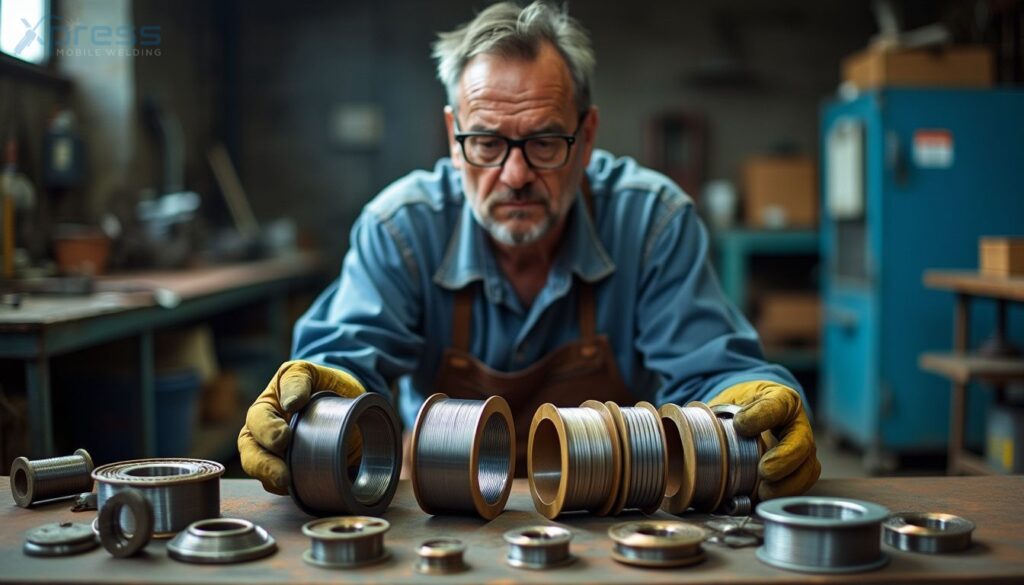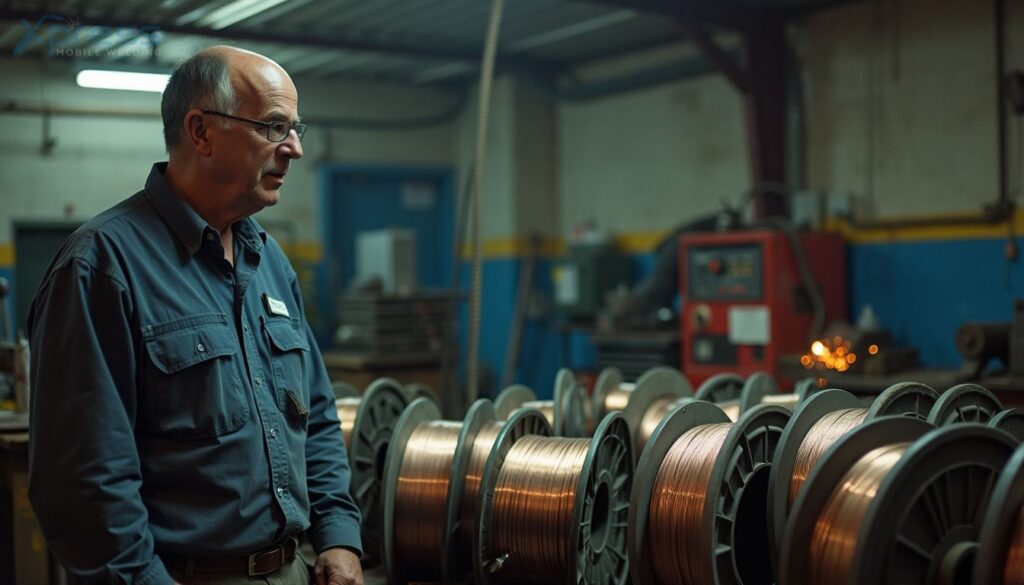Choosing the right flux core welding wire types can be tricky for many welders. There are two main types: self-shielded and gas-shielded. This guide will make it easier to pick the best flux-core wire for your projects.
Read on for all you need to know.
Key Takeaways
- Flux core welding wires come in two main types: self-shielded and gas-shielded. Self-shielded wires create their own shielding gas, which is good for outdoor projects. Gas-shielded wires need an external gas source but provide cleaner welds.
- Wire diameter affects your welding work. Smaller diameters are better for thin materials to prevent burn-through, while larger diameters suit thicker materials needing deeper penetration.
- The alloy content of the wire can change how the weld holds up under different conditions. Wires made for stainless steel contain more chromium and nickel to resist rusting, whereas those designed for carbon steel are great for general repairs.
- Shielding gases protect the weld from air that might spoil it. Self-shielded wires don’t need an extra gas supply, making them portable and handy in remote or windy locations.
- When choosing a flux core wire, consider the material thickness you’re working with and the position of your welds. Different positions require specific wire features to ensure quality welds.
Comprehensive Overview of Flux Core Welding Wire Types

Discover the world of flux core welding wire types, exploring their unique features and applications. Reveal the differences between self-shielded and gas-shielded flux-cored wires, and reveal the key to selecting the most appropriate option for your particular welding projects.
Exploring Self-Shielded Flux-Cored Wires
Self-shielded flux-cored wires are a game-changer for many welders. They create their own shielding gas as they burn. This means you don’t need an extra gas cylinder on your job site.
These wires work well in places where carrying heavy equipment is tough. Think about using them when you’re up on a bridge or working on a big steel frame outdoors. Because they’re so mobile, they make welding in remote areas much easier.
These wires do have some downsides, like making more smoke and spatter compared to other types of welding wires. But their efficiency sits around 65%. Plus, they mostly use direct-current electrode negative (DCEN).
This makes them ideal for projects outside, such as building bridges or ships. When setting them up, getting the right electrode extension is key—often more than two inches long—to ensure the best results for your welds.
Understanding Gas-shielded flux-cored wires need an external shielding gas. These gases can be 100% CO2 or a mix of argon and CO2. They help protect the weld from air that can harm it. This type of wire works well in shops because you can control the welds better, and they look nice.
People use them to build heavy machines and do general fabrication jobs.
These wires cost less than others because they have less material inside them. But they still work very well, with an efficiency of 75 to 85%. If you use CO2, it’s cheaper but makes more spatter.
A mix of gases gives you smoother weld beads.
Distinguishing Characteristics of Flux Core Wires

Flux core wires exhibit varying diameters, alloy content, and shielding requirements. These wires come in different diameters and offer a range of options for welding thicknesses. They also contain various alloy compositions that directly impact the properties of the welds they produce.
Analyzing Wire Diameter Variations
Wire diameter plays a big role in flux core welding. Different sizes offer unique benefits and challenges during the welding process. Here is a look at how variations in wire diameter affect flux core welding:
- Smaller diameters like 0.035 inch are widely used for thin metal sheets. They allow for precise welds with less heat input, reducing the risk of warping the metal.
- The 0.045-inch wire offers a good balance between flexibility and speed. It works well on medium-thickness materials, making it popular in auto repair and general fabrication.
- A 0.052-inch wire increases deposition rates, suited for thicker metals or faster welding speeds without compromising weld quality.
- The 1/16-inch option steps up the game for thicker materials, providing deep penetration and strong welds on heavy-duty applications such as construction and shipbuilding.
- Wires that measure 5/64 and 3/32 inch excel in industrial projects, where high deposition rates are crucial to productivity.
- Large diameters need V-knurled drive rolls for smooth feeding due to their softer nature, ensuring consistent wire feed speed and steady arc performance.
- Correct electrode extension varies with wire size; especially important for self-shielded wires which often require more than 2 inches to shield the weld pool adequately from atmospheric contamination.
Each diameter choice impacts everything from the equipment you need (like V-knurled drive rolls) to the way you manage your project parameters (such as electrode extension). Understanding these nuances lets welders select the right wire for their specific task, whether it’s delicate sheet metal work or robust industrial constructions.
Examining Alloy content in flux core welding wires plays a crucial role. It affects the weld’s durability and flexibility.
- Flux-cored wires for stainless steel have higher chromium and nickel contents. This makes the welds resistant to rust.
- Wires marked with “T-1” like E70T-1C are suitable for carbon steel. They cater to general repairs and fabrication needs.
- The “M” in a classification, such as E71T-1M, signifies a mix of CO2 and argon gases is needed. This mix improves the smoothness of the bead.
- Low-alloy steel wires contain elements like molybdenum and vanadium. They increase strength and withstand harsh conditions.
- High-alloy wires are used for tougher materials, providing a match in mechanical properties.
- AWS classifications help pick the right wire. For example, E70T-1C shows it’s for mild steel with 70,000 PSI tensile strength using CO2.
- The “H8” at the end of a wire type indicates low hydrogen levels. This reduces cracking risks in the weld metal.
- Certain flux-cored wires offer all-position welding capabilities due to their alloy composition and slag type, making them versatile tools.
Each variety addresses specific needs based on material type and desired outcomes in welding projects, ensuring optimal performance and longevity of welded structures or components.
Evaluating Shielding Requirements
Shielding gas plays a crucial role in flux core welding. The type of wire selected directly affects the requirement for shielding gas. Here is a simple guide:
| Type of Wire | Shielding Requirement | Pros | Cons |
|---|---|---|---|
| Self-Shielded Flux-Cored Wires (FCAW-S) | No external gas necessary | Portable, suitable for outdoor use | Increased spatter, less smooth bead appearance |
| Gas-Shielded Flux-Cored Wires (FCAW-G) | Needs external gas (100% CO2 or argon/CO2 mix) | More uniform bead, reduced spatter | Not optimal for windy environments, added cost for gas |
Self-shielded wires create their own protective atmosphere from the surrounding air. This makes them ideal for external jobs where no gas cylinder is required. On the other hand, gas-shielded wires necessitate an additional gas source, either 100% CO2 or a blend of CO2 and argon. CO2 is more cost-effective but can lead to messier welding, while mixed gases result in cleaner welds. Both types of wires require a machine capable of consistent voltage to maintain a stable welding process. Your project’s specific needs will determine which wire is most suitable. Shielding gas safeguards the weld from atmospheric contamination that can impair its quality. Selecting the appropriate wire and gas ensures a more efficient welding experience.
Selecting the Appropriate Flux Core Wire for Your Welding Project

Selecting the appropriate flux core wire for your welding project entails taking into account material thicknesses and various welding positions. Wires come in different diameters and possess distinct welding traits customized for particular applications, which can influence the quality and effectiveness of the weld. Ensuring that the wire type aligns with your project’s needs is vital for attaining top-notch outcomes.
Considerations for Different Material Thicknesses
Choosing the right flux core wire for your welding project depends heavily on the thickness of the materials you plan to join. Different material thicknesses require specific wire characteristics to ensure a strong, durable weld. Here’s what to consider:
- Thin materials work best with smaller wire diameters, such as 0.035 inches. This size provides better control over the welding arc and less heat input, reducing the risk of burn-through.
- For medium thickness materials, a 0.045-inch diameter wire is often ideal. It strikes a balance between penetration and heat input, suitable for most general welding tasks on mild steel or low-alloy steel.
- Thick materials demand larger wire diameters like 7/64 inches. These wires offer deeper penetration necessary to fuse thick sections together effectively.
- Self-shielded wires are preferable for outdoor projects or in conditions where using a shielding gas is impractical due to wind disrupting the gas shield.
- Gas-shielded wires ensure cleaner welds with less spatter when working indoors or in controlled environments, making them perfect for thinner materials that can be sensitive to welding conditions.
- Check the base metal’s compatibility with the wire alloy content. Wires designed for mild steel may not be suitable for welding high-strength low-alloy steel without risking weld integrity.
- Verify the required electrical setup; some flux core wires need direct current electrode positive (DCEP), while others may operate with alternating current (AC).
- Finally, consider the weld position required by your project; some flux core wires are specifically formulated to perform well in overhead or vertical positions due to their slagging characteristics that support the weld puddle until it cools.
These considerations help match flux core wire features with your project’s demands, optimizing weld strength, appearance, and overall success.
Choosing Wires Based on Welding Positions
Selecting the right flux-cored wire for your welding position ensures a strong weld. Each position, whether flat, vertical, overhead, or horizontal, has unique requirements.
- Flat and Horizontal Positions: Here, you can use both gas-shielded and self-shielded wires. Gas-shielded flux-cored wires offer low spatter and high efficiency indoors. For outdoor projects like bridge construction, self-shielded wires excel because they don’t need an external shielding gas.
- Vertical Welding: This position often requires a flux-cored wire with excellent slag removal for cleaner welds. Self-shielded wires work well here because their design helps control the weld puddle in vertical positions.
- Overhead Positions: Choose a wire with a smaller diameter to reduce the chance of droplets falling during welding. Self-shielded wires are preferred for their ease in controlling the molten pool from various angles.
- Material Thickness: Thinner materials benefit from smaller diameter wires that offer precision and prevent burning through the metal. Thicker materials work well with larger diameters that fill joins faster.
- Welding Power Source and Polarity: Check your power supply’s compatibility with the wire type. Most flux-cored welding requires DC electrode negative polarity, but always verify with the manufacturer’s recommendations.
- Environmental Conditions: For outdoor welding jobs, self-shielded wires are ideal as they are designed to withstand wind without needing shielding gas. Indoor applications can utilize gas-shielded wires for better arc stability and less pollution.
Understanding these tips will guide you in selecting the appropriate flux-cored wire based on your specific welding position needs.
Conclusion
Picking the right flux core wire matters a lot for your welding projects. You now know about self-shielded and gas-shielded wires, and how they fit different jobs. Whether you work with mild steel or exotic alloys, there’s a flux core wire that meets your needs.
Keep in mind the material thickness and the welding position when choosing your wire. With this guide, finding the best option becomes easier, ensuring high-quality welds every time.
This knowledge boosts both speed and results in various industries from construction to shipbuilding.
Get Professional Mobile Welding Services Near You
Transform your welding abilities with Xpress Mobile Welding in Chandler, AZ! We offer expert stick welding training customized to your skill level, right at your location. Our hands-on approach ensures you gain the confidence you need. Don’t hesitate—contact us today to embark on your welding mastery journey!

